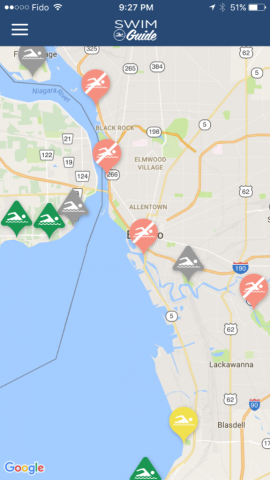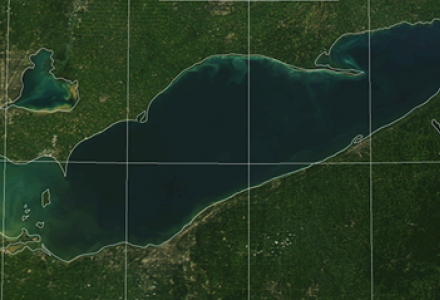
In 2011, a small team in Toronto launched the first version of Swim Guide, a smartphone app and website that helps people easily access data from beach water quality monitoring programs and find clean places to swim.
Swim Guide, an initiative of Swim Drink Canada, was created in response to a frequently asked question by the public: “Is it OK to go in the water today at the beach?”

The stated primary purpose of recreational water quality monitoring all over the world is to protect the public from contaminated water. When recreational water quality information is clearly and promptly communicated to the public, people can take measures to protect their health and the health of family and friends.
There are more than 1,000 monitored Canadian and US beaches in the Great Lakes. Yet the public faces barriers when searching for answers to questions about the water quality at their beach or swimming hole and potential health impacts.
Data from recreational water quality monitoring programs can be difficult to find, buried on websites or phone hotlines that aren’t easy for people to locate. It can take anywhere from 24 hours to a week or more from the time a sample is taken to the time the public has access to test results. This means information the public receives often does not reflect current water quality.
In addition, recreational water quality data can be presented in a way that is difficult for the public to understand. There is little consistency in the way data is presented. Datasets are often incomplete, missing essential information such as the date the sample was taken or the sample location.
Health Impacts
When water quality is not promptly and clearly communicated, there can be serious consequences to the health of recreational water users.
The impact of contaminated waters on the health of communities and the economy is startling. A 2018 University of Illinois study found that 4.04 billion recreation water events, such as swimming or surfing, occur annually in the U.S., resulting in an estimated 90 million illnesses nationwide and cost the country $2.2-$3.7 billion annually.
The study was the first to quantify the number of recreational water illnesses and the economic burden of these illnesses on a national scale. The study found that about 65 percent of the annual national cost is attributed to recreational water illnesses that “resulted in contact with a health care practitioner or evaluation in an emergency department.” In Canada, an estimated 3-8 percent of people get sick after swimming, according to the journal Canadian Family Physician.

A 2017 “State of the Great Lakes” report by Canadian and US environmental agencies found the status of beaches to be “fair to good,” based on how often they’re unsafe for swimming due to bacterial contamination.
Making recreational water quality data open is an effective way to address challenges the public faces in accessing and interpreting recreational water quality. The Canadian government defines open data as “structured data that is machine-readable, freely shared, used and built on without restrictions.”
Recreational water quality data is slowly beginning to be shared openly in places like Toronto and Chicago. However, the interoperability, the ability to exchange and use the data, is being impeded by a lack of consistency in the way dataset are structured and managed.
Open Data Standard
In 2017, Swim Guide received a grant from the Canadian Internet Registration Authority to develop a standard for exchanging recreational water quality data. In collaboration with the US Environmental Protection Agency, Surfrider Foundation, River Network and Alberta Health services, the first-ever open data standard was developed for the automated exchange of recreational water quality. The first version of the open data standard was published earlier this summer and is available online. For recreational water quality data, open access means people can access the complete data set as quickly as it becomes available.
Swim Guide and Swim Drink Fish Canada plan to use the standard in 2018 to make beach water quality information more accessible to the public via the Swim Guide app and website, which includes data on Canadian and US beaches.
Information also is available via the open data portal of monitoring bodies who have adopted the standard, such as the Surfrider Foundation’s Blue Water Task Force program, which is active in 35 chapters in Canada and the U.S.
Open data empowers people with the knowledge they need to better protect their health from contaminated water. And more importantly, open access to information about the health of their favorite beaches will help people have great days and build great memories on the water.

Gabrielle Parent-Doliner is program manager for Swim Guide, a Swim Drink Fish Canada initiative, based out of Toronto, Ontario.



